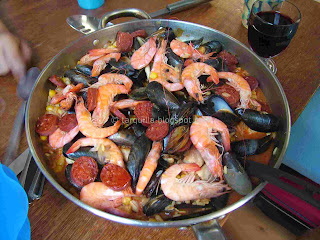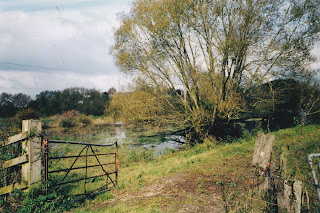Flavours of Biscay.
How can anyone govern
a nation that has two hundred and forty-six different kinds of cheese? Charles
de Gaulle
Obviously Charles de Gaulle was referring to the political
differences between all the regions but as the quote demonstrates there are a
few different types of cheese in France
 |
| One of the many cheeses we have tried and enjoyed |
As we travelled through the Basque country we discovered the
cultural importance of peppers. With enormous peppers of interesting shapes in
shades of red and green in sauces, stews, pour on sauce, dried, pickled,
hanging from balconies in fact you name it, it had peppers on or in! There were
many tasty dishes including a chicken in pepper sauce and a Basque lamb
stew. We also stocked up on some lovely red pepper Basquaise sauce which we
have used with many things.
Seafood is, not surprisingly, something we come across quite
frequently. You may have noticed us mention mussels on several occasions. When
visiting fishing ports during the summer months, freshly caught sardines are
often found grilling beside the harbour wafting their perfumed smoke around. In
other areas it is the shellfish which rule. Oysters are often considered in Britain Tabasco
 |
| home made paella |
Coming up the west coast of France
we stopped in the Gironde region which is famed
for its wines. The Bordeaux
 |
| Medoc wine from the Gironde |
 |
| Pineau de Charentes from La Rochelle |
Although Churros are a Spanish treat (traditionally eaten
with a hot chocolate for dipping) many towns on the Atlantic coast of France
Another unusual meal was steak tartare. Ordered by the
middle deck hand at a restaurant in Le
Mans
The skipper enjoys finding and trying out local and
traditional recipes. Kig ar farz (literally meat and stuffing) is a traditional
Breton recipe which used to be prepared by peasants and left to simmer over the
fire whilst they worked the fields. The dumpling is made using buckwheat and is
cooked over the stew in a muslin bag. This has now been added to his repertoire
of successful dishes.
 |
| oysters, sausage, bread and lemons from the market washed down with local cider |
Seaweed pate, cured and smoked sausages (with herbs, with
garlic, kangaroo, rabbit, mushroom and various others) fish soup,
snails and pastries have all been tried by the crew. They are very good at
trying new things and we all love going to the markets. Mixed in with old
favourites and a lot of basics we are loving trying regional flavours. Salud.
You can also follow Tarquilla on Facebook
All the way through
this journey we’ve enjoyed trying different foods.
Similar blogs can be found via these links.
http://themonkeysfist.blogspot.com/2013/06/eat-to-sail-sail-to-eat.html




Comments
Post a Comment